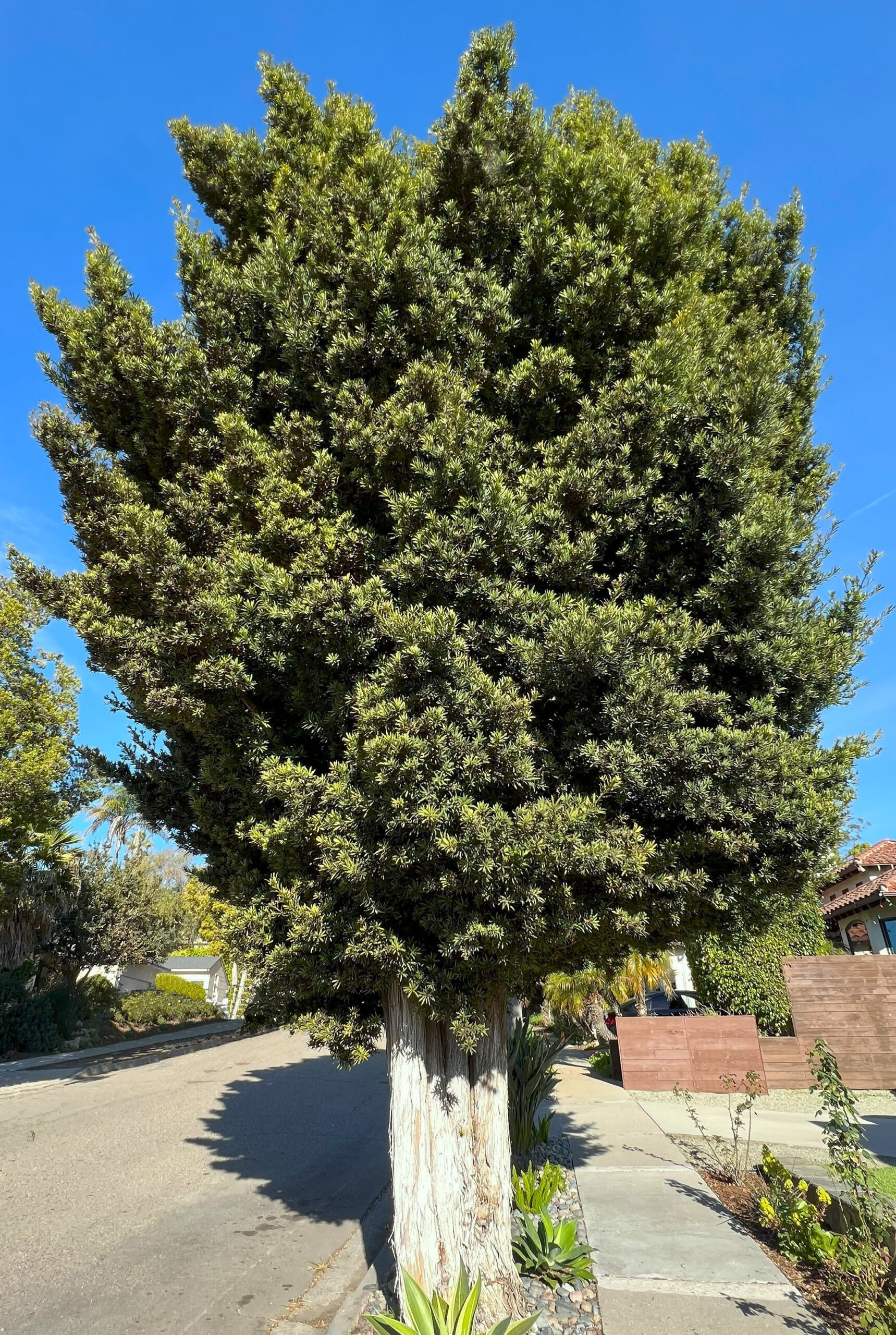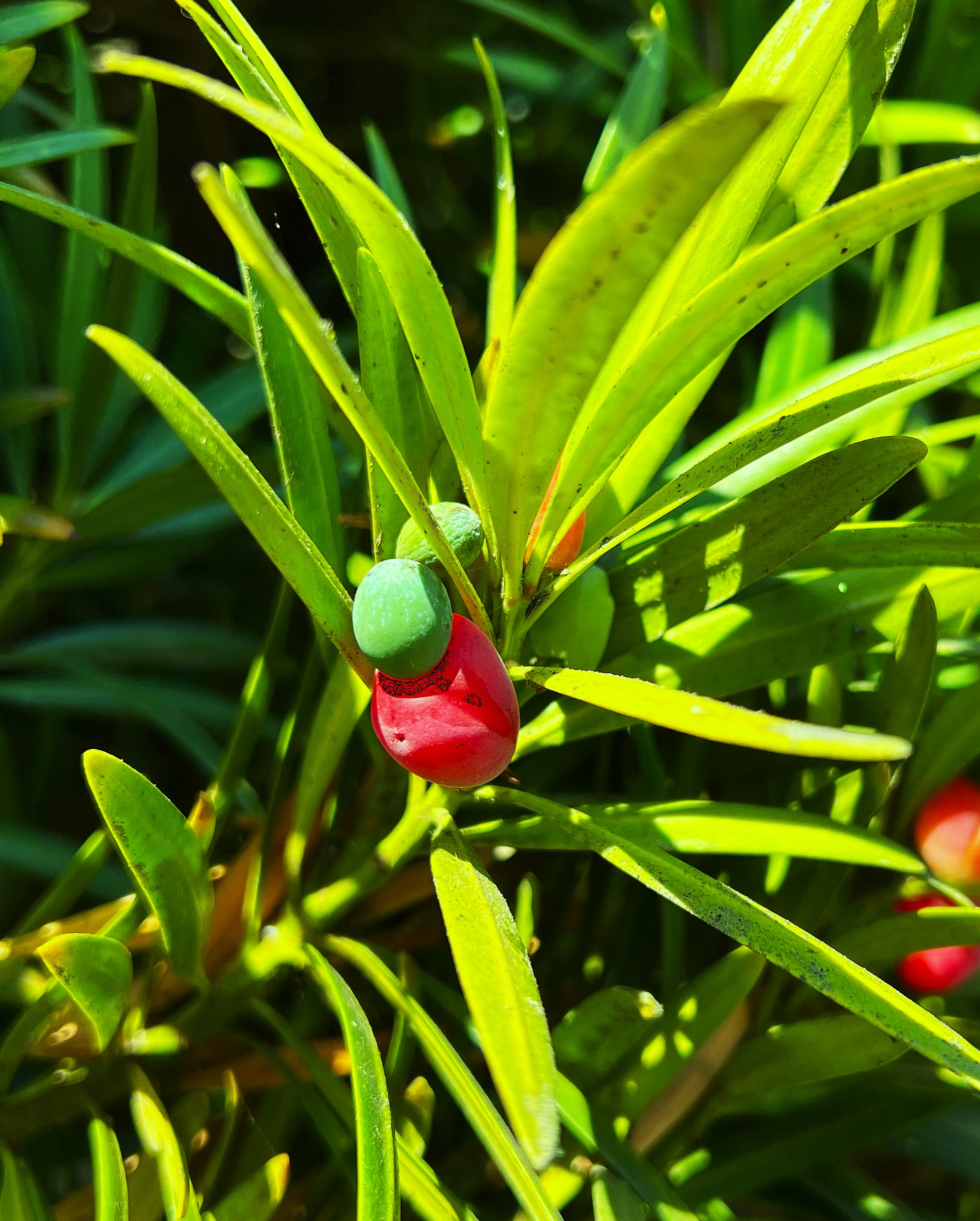The Japanese Yew Pine is a tidy and sustainable small- to medium-sized evergreen conifer that does quite well in Santa Barbara.
 This low-maintenance, drought-tolerant tree naturally grows in shrub form and is frequently used for screening and hedging. When trained into a tree, it typically reaches 20- to 40-feet in height with a spread of 15- to 30-feet, although it can grow larger in ideal conditions.
This low-maintenance, drought-tolerant tree naturally grows in shrub form and is frequently used for screening and hedging. When trained into a tree, it typically reaches 20- to 40-feet in height with a spread of 15- to 30-feet, although it can grow larger in ideal conditions.
Japanese Yew Pine should not be confused with its near relative, the Fern Pine (Afrocarpus gracilior), which is planted here in much greater numbers, as both a tree and a hedge, and is quite similar in appearance – but which has smaller and more delicate leaves and can grow relatively larger in size.
The branches of Japanese Yew Pine grow upright and are covered with leathery, linear-lanceolate-shaped, long (up to 4-inches in length and ½-inch in width), yew-like, needles (leaves) that are arranged in dense spirals around the branches. The dark green leaves are glossy on top and paler underneath.
The fibrous bark is quite notable on mature trees, as it peels off in light brownish-gray strips.
 The Japanese Yew Pine is “dioecious”, meaning it has two genders – appearing as either a male tree or a female tree. Male trees have small pollen-producing cones that appear in clusters of catkin-like spikes (1½-inch long) that form at the ends of branches. Female trees have seed cones that appear as scales (3/8-inch long) that also form at the end of branches.
The Japanese Yew Pine is “dioecious”, meaning it has two genders – appearing as either a male tree or a female tree. Male trees have small pollen-producing cones that appear in clusters of catkin-like spikes (1½-inch long) that form at the ends of branches. Female trees have seed cones that appear as scales (3/8-inch long) that also form at the end of branches.
Distinctively and unlike most other conifers, its fertilized seed cone develops into a small (½-inch long) oval-shaped “drupe” (a seed lightly covered with flesh) that sits right on top of a fleshy berry-like “aril” (a base – ¾ inch in diameter), which turns reddish-purple when mature. The seeds are eagerly eaten by birds, which will subsequently disperse the seeds – along with a dollop of their “fertilizer”. The seeds are not edible by humans, but the ripe aril berries are; they can be enjoyed raw or used in baking. All the cones tend to blend into the foliage, so it requires close observation to see them.
 Japanese Yew Pine has several other common names, including “Japanese Fern Pine”, “Buddhist Pine”, and “Southern Yew”. It should be noted that the tree is, in fact, neither a yew, nor a pine, nor a fern – common names so often being misleading.
Japanese Yew Pine has several other common names, including “Japanese Fern Pine”, “Buddhist Pine”, and “Southern Yew”. It should be noted that the tree is, in fact, neither a yew, nor a pine, nor a fern – common names so often being misleading.
Japanese Yew Pine is in the plant family Podocarpaceae. Its botanical name is Podocarpus macrophyllus. The genus name, Podocarpus, is a combination of the Greek words, “podos”, meaning “foot”, and “karpos”, meaning “seed”, and refers to the aril that forms a base on which the seed stands. The specific epithet, macrophyllus, is from Latin and means “large-leaved”.
It is the northern-most growing species in its genus, being endemic to the forests of southern Japan and eastern China. In its native range, it has been planted extensively as an ornamental plant or tree. Its hard and termite-resistant wood makes it valuable for lumber used in high quality construction and carpentry. In Hong Kong, it is considered an auspicious “feng shui” tree with a resulting high monetary value.
The Japanese Yew Pine is easy to grow in our area. It can be planted in full sun or shade. It does best in slightly acidic loam soil – but will tolerate heavier soils, if they are well-drained. In alkaline soils, it can become chlorotic (showing yellowing leaves), which can be treated with an acidifying fertilizer.
Once established, it is drought-tolerant – but will appreciate additional irrigation during the dry season. It is completely cold-tolerant in our Mediterranean climate. It can be propagated by seed and through soft-wood cuttings.
It does not appear to have significant problems with plant diseases or insects. That being said, sometimes sap-sucking aphids will infest new foliage – the droppings of these pesky bugs will develop an unsightly sooty mold on the leaves. An application of hungry aphid-eating lady bugs – or a good washing of the leaves with soapy water, as well as control of ant infestations (ants herd and protect aphids for their honeydew) – should solve this problem.
This attractive and versatile tree is well suited to our climate and makes a lovely addition to any garden or landscape.
Mature Japanese Yew Pines can be seen as street trees on San Julian Avenue in the Mesa neighborhood. Not surprisingly, there are several beautifully pruned specimens in the “Japanese Garden” (standing in and adjacent to the “karesansui” (dry landscape) section) of Ganna Walska Lotusland.
Tree-of-the-Month articles are sponsored by Santa Barbara Beautiful, whose many missions include the increase of public awareness and appreciation of Santa Barbara’s many outstanding trees and, in a long-time partnership with the City Parks & Recreation Department, the funding and planting of trees along the City’s streets.
Those who wish to honor a special someone can do so with an attractive commemorative marker that will be installed at the base of an existing street tree in the City of Santa Barbara. Because Santa Barbara Beautiful has participated in the planting to date of over 14,000 street trees, there are plenty of trees from which to choose! Application forms are available on the Santa Barbara Beautiful website, www.sbbeautiful.org.
Article and Photos by David Gress
